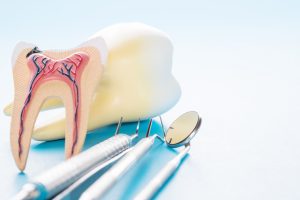 While advanced dental technology makes receiving lifelike implants much more streamlined and efficient, the fact of the matter is that most would avoid the need for replacements and instead maintain their natural teeth if given a choice. Indeed, adult tooth loss can be a frightening experience, and more often than not, significant damage has occurred before one even recognizes that there is a problem to begin with. Fortunately, there are also many stages in which decay and other concerns can be treated before it is too late. In today’s blog, your Leawood, KS dentist describes the process behind removing dental decay, even when it infects your inner tooth and causes damage to your nerves.
While advanced dental technology makes receiving lifelike implants much more streamlined and efficient, the fact of the matter is that most would avoid the need for replacements and instead maintain their natural teeth if given a choice. Indeed, adult tooth loss can be a frightening experience, and more often than not, significant damage has occurred before one even recognizes that there is a problem to begin with. Fortunately, there are also many stages in which decay and other concerns can be treated before it is too late. In today’s blog, your Leawood, KS dentist describes the process behind removing dental decay, even when it infects your inner tooth and causes damage to your nerves.
An Ongoing Concern
Because there are countless sources of threats to your oral health, it makes sense that sticking to a well-rounded preventive dental routine is going to be a lifelong commitment. After all, threats such as decay, damage, and more do not simply cease once one hits a certain age. Due to this fact, it is up to us to ensure that our smiles are being taken care of properly.
As one of the most common dental concerns out there, oral bacteria begin like many other issues with hyperactive oral bacteria. These bacteria feed off of sugars and food particles that cause them to secrete destructive acids, which aid in the decay process. In many situations, you may first notice this phenomenon as a simple cavity within a tooth. Without treatment, however, it will continue to develop and worsen, inevitably resulting in significant damage or worse.
From Healthy to Compromised
While an oral structure does not go from healthy to compromised overnight, there are a number of indicators to pay mind to that signify unhealthy teeth. For instance, if you begin to experience sharp pains when consuming hot or cold items, this could be a sign that something is wrong and affecting your inner nerves. What’s more, difficulty or pain while biting and chewing, or the inability to fully open your mouth are indicative of something amiss as well.
Removing Decay at the Core
If You are experiencing any of the symptoms mentioned above, chances are you may have an infected tooth on your hands. To preserve your natural structure, your dentist may recommend a root canal procedure to help remove the infected pulp. Once gone, your hollow canals will be filled with a dental material to provide stability and reinforcement, then finished with a dental crown to promote proper healing.
Root canal treatments are often one of the last options your dentist may consider before resulting in extraction. If your tooth cannot be saved, the latter option is your best bet to preserve your health. To avoid these concerns, however, make sure to stay on top of your health and attend your routine checkups so we can ensure minor concerns do not become major ones.
Learn More Today
For more information about your restorative options or to schedule your appointment with our team, contact Dreem Dentistry in Leawood, KS by calling 913-681-5500 today.





